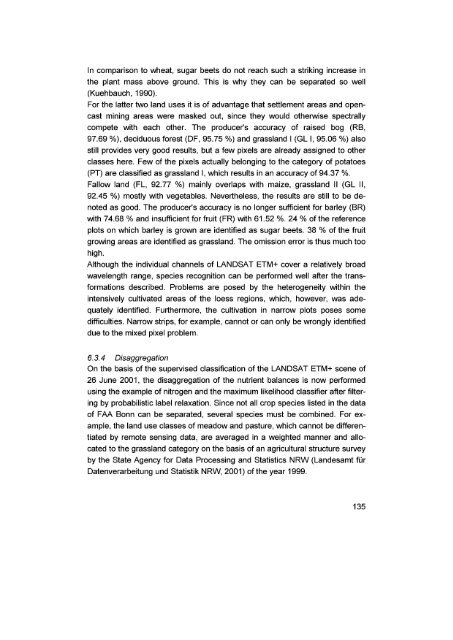IP-W " ~ - ` - JUWEL - Forschungszentrum Jülich
IP-W " ~ - ` - JUWEL - Forschungszentrum Jülich
IP-W " ~ - ` - JUWEL - Forschungszentrum Jülich
Create successful ePaper yourself
Turn your PDF publications into a flip-book with our unique Google optimized e-Paper software.
In comparison to wheat, sugar beets do not reach such a striking increase in<br />
the plant mass above ground . This is why they can be separated so well<br />
(Kuehbauch, 1990) .<br />
For the latter two land uses it is of advantage that settlement areas and opencast<br />
mining areas were masked out, since they would otherwise spectrally<br />
compete with each other . The producer's accuracy of raised bog (RB,<br />
97.69 %), deciduous forest (DF, 95.75 %) and grassland I (GL I, 95.06 %) also<br />
still provides very good results, but a few pixels are already assigned to other<br />
classes here. Few of the pixels actually belonging to the category of potatoes<br />
(PT) are classified as grassland I, which results in an accuracy of 94.37 %.<br />
Fallow land (FL, 92.77 %) mainly overlaps with maize, grassland II (GL II,<br />
92.45 %) mostly with vegetables . Nevertheless, the results are still to be denoted<br />
as good . The producer's accuracy is no longer sufficient for barley (BR)<br />
with 74.68 % and insufficient for fruit (FR) with 61 .52 %. 24 % of the reference<br />
plots on which barley is grown are identified as sugar beets . 38 % of the fruit<br />
growing areas are identified as grassland . The omission error is thus much too<br />
high .<br />
Although the individual channels of LANDSAT ETM+ cover a relatively broad<br />
wavelength range, species recognition can be performed well after the transformations<br />
described . Problems are posed by the heterogeneity within the<br />
intensively cultivated areas of the loess regions, which, however, was adequately<br />
identified . Furthermore, the cultivation in narrow plots poses some<br />
difficulties . Narrow strips, for example, cannot or can only be wrongly identified<br />
due to the mixed pixel problem .<br />
6.3.4 Disaggregation<br />
On the basis of the supervised classification of the LANDSAT ETM+ scene of<br />
26 June 2001, the disaggregation of the nutrient balances is now performed<br />
using the example of nitrogen and the maximum likelihood classifier after filtering<br />
by probabilistic label relaxation . Since not all crop species listed in the data<br />
of FAA Bonn can be separated, several species must be combined . For example,<br />
the land use classes of meadow and pasture, which cannot be differentiated<br />
by remote sensing data, are averaged in a weighted manner and allocated<br />
to the grassland category on the basis of an agricultural structure survey<br />
by the State Agency for Data Processing and Statistics NRW (Landesamt für<br />
Datenverarbeitung and Statistik NRW, 2001) of the year 1999 .<br />
135

















